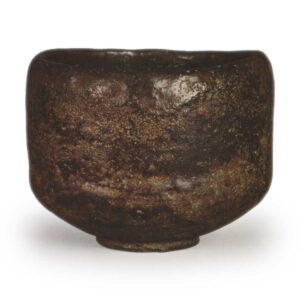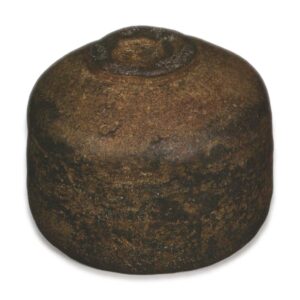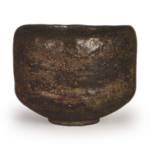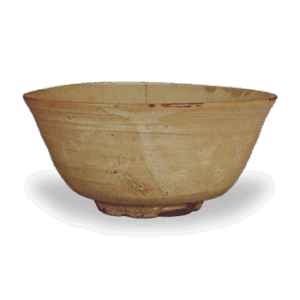

Held in the collection of the Atami Museum of Art
Height: 8.3 – 8.9 cm
Diameter: 10.2 – 10.5 cm
Outside diameter of foot: 4.6 – 4.8 cm
Height of foot: 0.5 – 0.6 cm
The Ayame is a tea bowl with a mysterious charm, even among Chojiro’s Kuro Raku tea bowls. Even though it is black, there are also areas that are tinged with brown and others that are white, giving it a complex color. At first glance, the shape is similar to the Daikoku, but if you look closely, you will see that the mouth is different, the bulge of the waist is different, and the foot ring is also different. It is a bowl with a solid, thick feel, and the low foot ring gives it a very down-to-earth feel. Which of the first four Raku ware masters – Chojiro, Sokei, Sōmai and Jōkei – made this bowl? The “Nanbokuroku” (a book written by Sen no Rikyu) says that he used irises at a tea ceremony on May 4th, 1587, so it is probably the work of the first Chojiro, but compared to the works of Daikoku and Tarobo, which are also by the first Chojiro, it has a softer feel, as if it were made with a freer spirit, but it also has a solid, dignified quality.
I have one memory of “Ayame”. I think it was in the spring of 1944 or 1945, when the fighting was intensifying. There was a blackout, and someone came to my house in Kamakura.
The artists were Chokai Seiji and Imato Ko, and they had brought the painting “Iris” especially to show it to me. As the lights could not be turned on, I looked at it by candlelight, and was deeply moved by the indescribably complex undulations of the body, which could not be seen in bright light. The next morning, after the sun had risen, I looked at it again in the sunlight, but the excitement I had felt the night before had vanished like morning dew, and I felt nothing. When I was holding tea ceremonies in my humble clothes in the old days, I could see things that I can’t see now, and I may not have been able to see things that I can see now. Of all the tea bowls made by Chojiro, this one has a mysterious charm.
The clay body is not visible, but it is probably a red clay with a rough sandy texture. A dull, aged, leathery brown glaze covers the surface of the bowl in a thick layer. The inside and the rim are relatively black, but the body is a brownish-red color, and this is particularly noticeable from the base to the bottom of the bowl.
The bowl is hand-molded, with a bulging mouth and slightly flared waist, and the low, thick, stable foot supports the plump base. The bottom is shallowly concave, and there is no kobin. There are five large marks on the tatami mat.
Accessories: The inner box is made of plain Japanese cedar, and on the front of the lid is the inscription “Chojiro-yaki teacup” in Rikyu’s handwriting, and on the back of the lid is the inscription “Ayame (signature)” in Motohaku’s handwriting. The outer box is made of plain paulownia wood, and on the front of the lid is the inscription “Ayame Chojiro-saku (signature)” in Motohaku’s handwriting.
The accompanying letter shows that it was originally owned by Rikyu, and later passed from Eiraku Zengoro to Kusama Ihei, but other details are not known.








